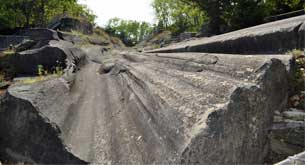Glacier Facts
Posted by A. Douglas / in Science Facts

Franz Josef Glacier in New Zealand
Glaciers are a large mass of ice that moves along the ground because of gravity forces. You might know that snow forms on the top of mountains. High elevation snow occurs all year, even in the summer months. If enough snow and ice occurs, this may be the start of a glacier. Glaciers also occur at places that do not warm much throughout the year. Ice sheets and ice caps near the north and south poles are also considered glaciers. Find out more glacier facts.
Facts about Glaciers
Glaciers are grouped into 3 categories:
- Valley glaciers
- Piedmont glaciers
- Ice sheets and ice caps
- Valley glaciers occur where an ice mass moves down the slope of a mountain, through an existing valley.
- Where several valley glaciers join together and form a flat shape, it is known as a Piedmont glacier. The name Piedmont is borrowed from a flat plateau geologic area in the Italian Alps.
- Ice sheets are massive areas of ice. There are currently multiple ice sheets on Earth, including major ice sheets in Antarctica and most of Greenland.
- Ice caps are smaller than ice sheets.
- Currently, glaciers cover about 10 percent of the surface of the Earth.
- Almost 99 percent of the ice trapped in glaciers is located in Greenland and the Antarctic.
- Glaciers contain almost 70 percent of the world's supply of freshwater.
- Scientists have measured the thickness of some Antarctic glaciers by drilling a core through the glacier. In some areas the glaciers are more than 2.5 miles (4.2 kilometers) thick!

The Equi Glacier in Greenland
How Glaciers Move and Shape the Land

Glacial Grooves like this one on Kelleys Island in Lake Erie, are left behind from moving glaciers across the bedrock.
- As snow and ice build up, gravity eventually pushes out the edges of the ice mass. This creates a "flow" of ice, similar to a river, but in very slow motion.
- Friction on the bottom of the ice mass heats up the ice causing it to melt when rubbing against the ground. With the surrounding cold from the ice mass, the melted ice typically refreezes.
- As the ice refreezes, it picks up soil, rock and boulders.
- When glacial ice contains rock and boulders it acts like a giant grinder, wearing away the soil and rock under the ice.
- The wearing of bedrock is so powerful that a glacier can actually carve grooves in the rock. There are some excellent preserved glacial grooves near the shores of Lake Erie in Ohio on Kelleys Island.
- Valley Glaciers carve our deep areas in the soil and rock. In some cases, this material is washed out to the sea, creating a narrow bay or inlet. These inlets are known as a fjord. Fjords are present in northern and southern land areas near the polar circles such as Norway and New Zealand. Many fjords have a deposit of material near the outlet, similar to a river delta.
- When glaciers begin to melt, all of the soil and rock that was picked-up by the moving glacier is left behind. These deposits of soil and rock are known as Moraines. In Ohio, there are several large examples of moraines left behind from glacial activity. There is a city known as Moraine, on the North side of Dayton, Ohio. Interstate 75 travels through the moraine area. If you are traveling on IR 75 north of Dayton, you will notice a large hill, which looks like a small mountain. This is a glacial moraine.

This fjord, located in Norway near the polar circle, was carved out by a glacier.
Interesting Glacier Facts
- Icebergs are the result of moving glaciers. When the glacial ice reaches the sea and there is no land or ice support under the glacier, it may break off. Some icebergs are quite large. A recent iceberg, named B-15, broke off Antarctica and was 2.8 million acres in size.
- Since the glacial ice is very cold and dense, icebergs can travel quite a ways from where they first entered the open ocean. Some glacial icebergs have been tracked to locations near the equator.
- Penguins live on the ice sheets on Antarctica and on the surrounding islands around Antarctica, and are sometimes found playing on icebergs. Penguins have insulated feet, allowing them to stand on the ice without freezing.
- Have you ever visited a glacier?

Penguins like these Emperor Penguins live on the ice sheets in Antarctica. Ice sheets are one of the types of glaciers.
